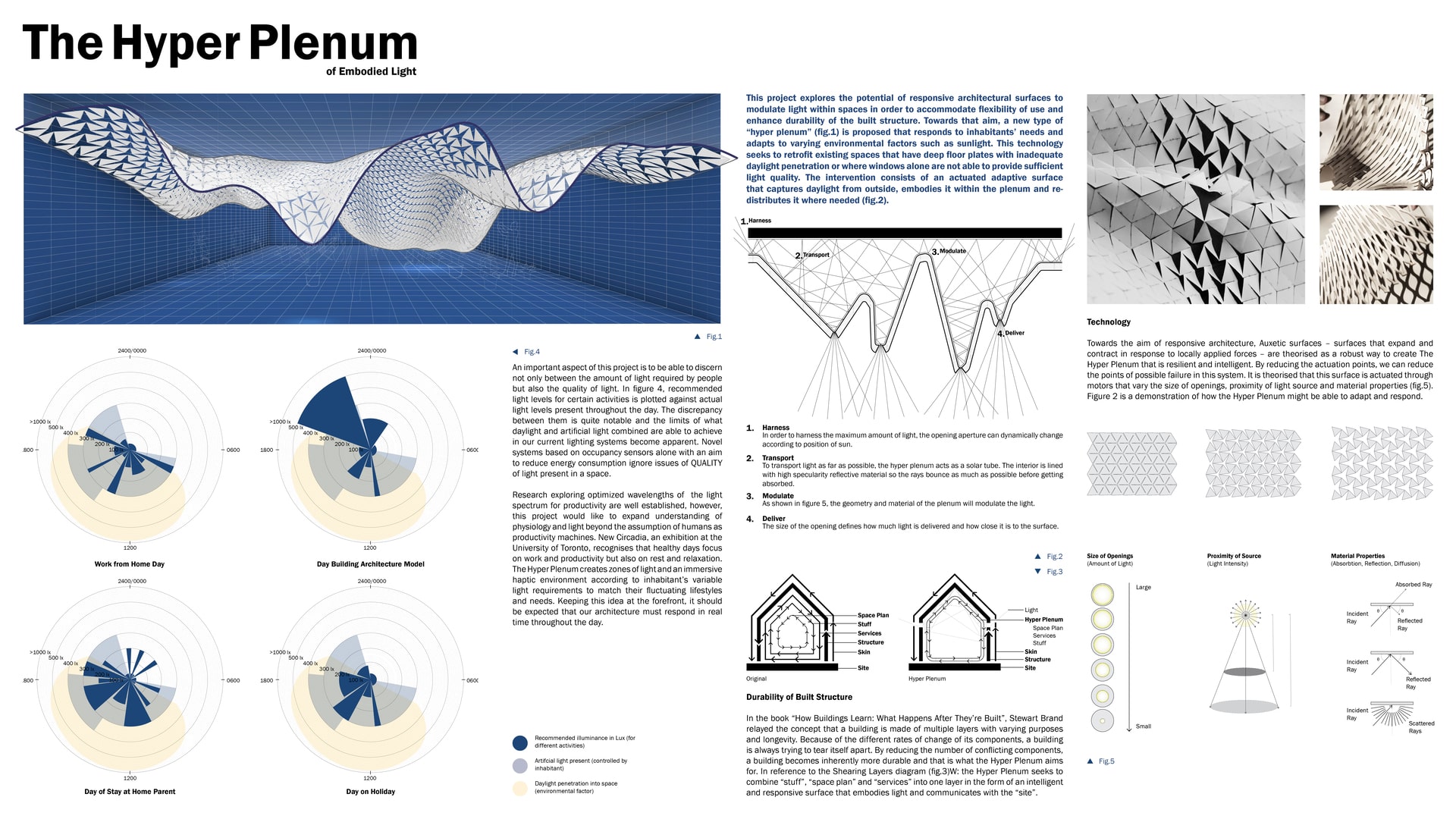Project Description
Abstract: This project explores the potential of responsive architectural surfaces to modulate light within spaces in order to accommodate flexibility of use and enhance durability of the built structure. Towards that aim, a new type of “hyper plenum” (fig.1) is proposed that responds to inhabitants’ needs and adapts to varying environmental factors such as sunlight. This technology seeks to retrofit existing spaces that have deep floor plates with inadequate daylight penetration or where windows alone are not able to provide sufficient light quality. The intervention consists of an actuated adaptive surface that captures daylight from outside, embodies it within the plenum and re-distributes it where needed (fig.2). Flexibility of Use: The concept of flexibility has been a recurring topic in architectural discourse, however, oftentimes a desire to create flexibility has resulted in a general lack of programming. This is most aptly demonstrated by the big box warehouses of the 21st century, however, Rem Koolhaas expressed that: “flexibility is not the exhaustive anticipation of all possible changes...flexibility is the creation of margin—excess capacity that enables different and even opposite uses.”[1] Taking Louis Kahn's Salk Institute as an example, a “specifically generic”[2] building is presented that separates the service spaces from the inhabited spaces to allow spaces to adapt as required from them. In Jonas Salk’s own words: the institute was “built with an evolutionary plan in mind; the capacity to adapt and to change is an integral part of the structure itself . . . it has developed new capacities, new functions, and new purposes.”[3] The key lesson to take away is that spaces are not statically used and this is something that has been proven by the COVID-19 pandemic. Architecture must be able to play a much larger role in people's health and accommodate wider use case scenarios than initially intended. The role of flexibility becomes more important as living spaces become work spaces or work places become places of emergency shelter and health care etc. Space changes throughout the day and this needs to be reflected in how architecture responds to needs, especially in terms of light. The Hyper Plenum being proposed is able to achieve that by creating a new typology of spaces whose use cases are flexible throughout the day and by modulating daylight. An important aspect of this project is to be able to discern not only between the amount of light required by people but also the quality of light. In figure 4, recommended light levels for certain activities is plotted against actual light levels present throughout the day. The discrepancy between them is quite notable and the limits of what daylight and artificial light combined are able to achieve in our current lighting systems become apparent. Novel systems based on occupancy sensors alone with an aim to reduce energy consumption ignore issues of QUALITY of light present in a space. Research exploring optimized wavelengths of the light spectrum for productivity are well established, however, this project would like to expand understanding of physiology and light beyond the assumption of humans as productivity machines. New Circadia, an exhibition at the University of Toronto, recognises that healthy days focus on work and productivity but also on rest and relaxation. The Hyper Plenum creates zones of light and an immersive haptic environment according to inhabitant’s variable light requirements to match their fluctuating lifestyles and needs. Durability of Built Structure: In the book “How Buildings Learn: What Happens After They’re Built”, Stewart Brand relayed the concept that a building is made of multiple layers with varying purposes and longevity. Because of the different rates of change of its components, a building is always trying to tear itself apart. By reducing the number of conflicting components, a building becomes inherently more durable and that is what the Hyper Plenum aims for. In reference to the Shearing Layers diagram (fig.3) the Hyper Plenum seeks to combine “stuff”, “space plan” and “services” into one layer in the form of an intelligent and responsive surface that embodies light and communicates with the “site”. Technology: Towards the aim of responsive architecture, Auxetic surfaces – surfaces that expand and contract in response to locally applied forces – are theorised as a robust way to create The Hyper Plenum that is resilient and intelligent. By reducing the actuation points, we can reduce the points of possible failure in this system. It is theorised that this surface is actuated through motors that vary the size of openings, proximity of light source and material properties (fig.5). Figure 2 is a demonstration of how the Hyper Plenum might be able to adapt and respond. [1] Koolhaas, Rem, Bruce Mau. Small, Medium, Large, Extra-Large: Office for Metropolitan Architecture. [2] Leupen, Bernard. Frame and Generic Space. [3] Moe, Kiel. Convergence: An Architectural Agenda for Energy.
